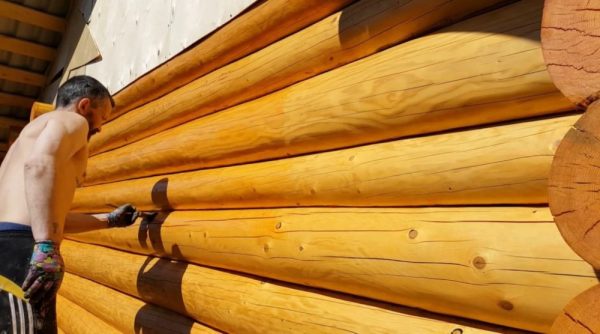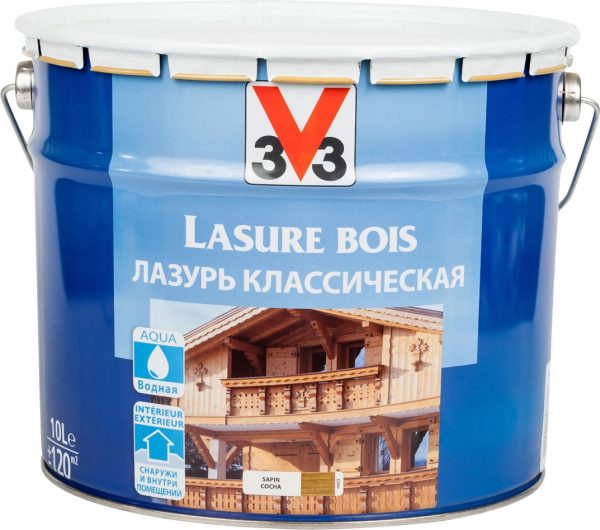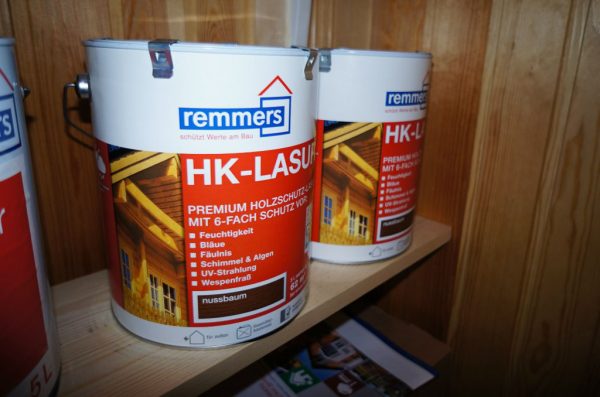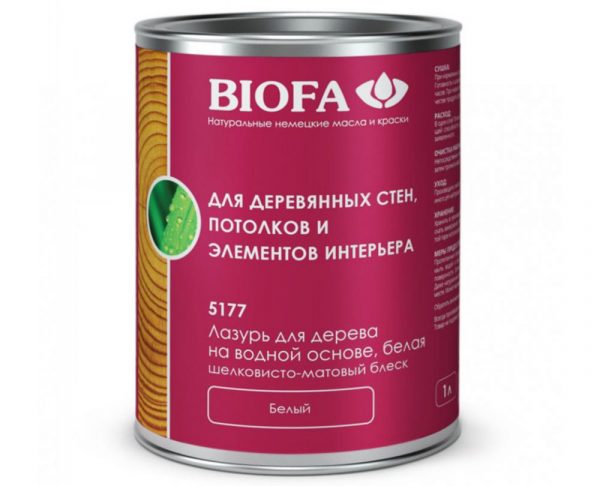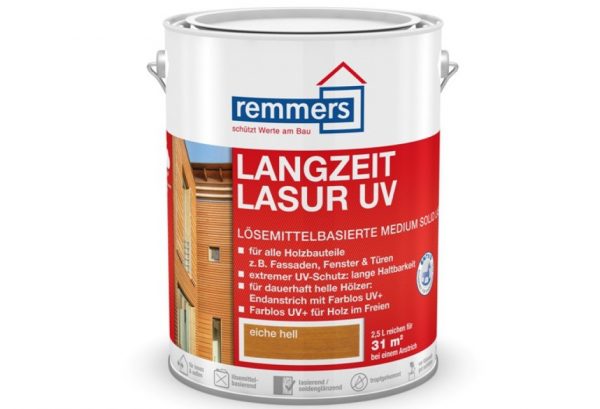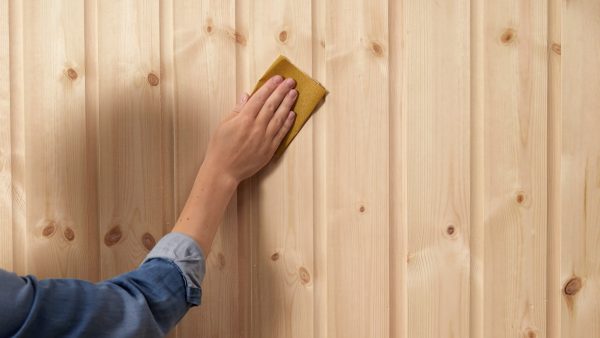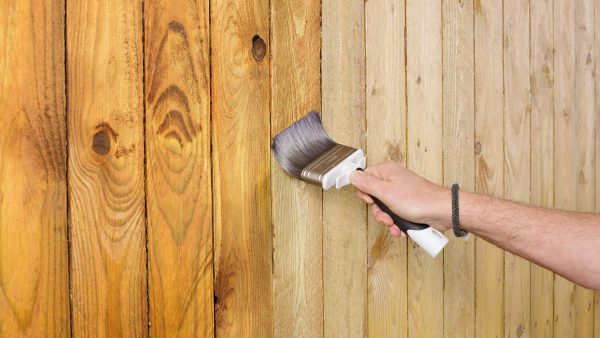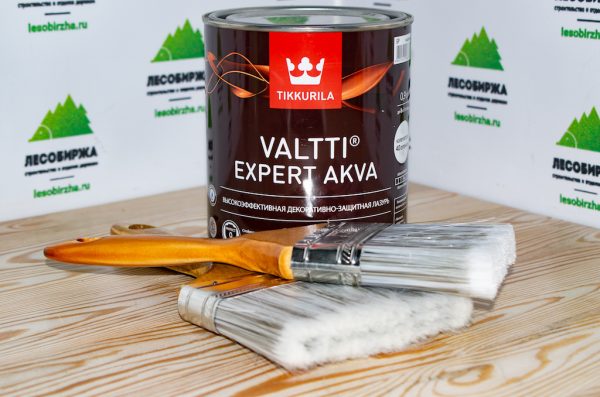Wood is a popular building and finishing material, natural and environmentally friendly, pleasant to the touch and positively reacting to the application of various coatings. But the tree has one peculiarity - it differs in porosity, therefore, due to the ingress of moisture, it can rot, deteriorate, become covered with a coating of fungus and mold over time.
- Why is azure needed
- Types of azure for wood
- Azure for interior decoration
- Azure for outdoor use
- Which is better: azure or tree oil
- Surface preparation for impregnation
- Features of applying oil impregnation
- Application of solvent-based azure
- The color variety of azure
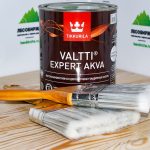
Azure for wood is a new product with impregnating ability and protecting the material from external influences.
Why is azure needed
Azure is understood as a glazing composition that strengthens the surface without changing the initial structure of the material. It is designed to extend the life of wood products and objects built from lumber. In addition, it is needed to improve the appearance of wood.

Azure has an antiseptic effect, therefore it prevents the appearance of a fungus, the settlement of wood-beetle beetles, the formation of an unpleasant blue. Particularly well-proven composition in relation to softwood, which in its natural form does not last long and require mandatory protective coating. Impregnation is introduced into the deeper layers of the material, strengthens the fibers, making them less susceptible to aging, cracking.
The use of glazing compositions prevents damage to building objects from ultraviolet radiation and precipitation. Some types of azure are called “filmless impregnations”, because after processing the vapor permeability of wood remains at the same level, but excess moisture evaporates, and the indoor microclimate improves.
Thus, the use of azure in the processing of timber, logs, boards allows you to protect them from negative damaging factors, while any material becomes stronger, more attractive, more durable.
to contents ↑Types of azure for wood
Depending on the base, wood azure can be water, oil or solvent. Characteristics of different types of impregnations are as follows:
- Water. The solvent in them is water. The composition also includes light-resistant pigments, biocidal substances, acrylic in the form of a dispersion. Lazuli perfectly penetrate wood (penetration is the highest among all means). They provide long-term protection against negative effects, are safe for human health, and are suitable for work in any premises, even in children’s, baths, saunas. From long storage, sediment may fall to the bottom of the azure, but to restore the properties, it is enough to simply shake the bottle.
- On solvents. Such compositions are most resistant to weather changes, precipitation, give a high degree of protection against UV radiation. Due to the presence of organic solvents or alkyd varnish, toxic substances evaporate to the point of complete drying of the azure, therefore it is usually used for outdoor applications.The composition of the impregnations of this group includes special resistant pigments that beautifully emphasize the structure of the tree.
- Oil. They are multicomponent compositions based on castor, linseed, sunflower, orange oil, rosin ether, vegetable alcohols. Such glazes prevent the appearance of the fungus, prevent yellowing and turning blue of the tree, favorably emphasize the structure of the fibers. Many oil products do not have color, while others contain various pigments to give a more saturated tone to wooden products.
According to the consistency and the degree of fluidity, all lessing compositions are divided into the following groups:
- Thin-layer (fluid). Quickly and deeply embedded between the wood fibers noble liquid texture. Due to the strong absorbency, a characteristic film is not formed on the surface of the lumber. Such glazes are ideally suited for unstable elements (lining, picket fence), as well as for products with complex shapes.
- Mid-layer (intermediate). They have a higher density, solidify on the surface in the form of a thin film, as they penetrate worse into the porous structure of the base material. Nevertheless, these impregnations better protect the tree from the negative effects of the external environment. They are well suited for structures that undergo minor deformation during operation (various frames, beams).
- Thick-layer (densely flowing). After drying, a strong film is formed on the surface of the wood. They are used only on products that are not subject to deformation (door blocks, interior decoration elements - house block, imitation timber), and are also excellent for protecting facades and structures outside.
Azure for interior decoration
Glazing compositions for work inside buildings and structures can be used on new and old wood, previously cleaned of paintwork. Most often they are applied to:
- window frames;
- doorposts;
- floor;
- ceiling beams;
- railings, stairs;
- Wall panels;
- furniture;
- decor.
Such azure is suitable not only for natural wood, but also for MDF, plywood, particleboard, veneer. Most often they are water-based and contain waxes and resins that give the wood a lacquered look. Impregnation for internal work helps to hide small defects of the base, preserve the natural appearance of the tree and emphasize its beauty. Colored pigments are often added to the compositions, providing the material with even greater decorative effect. Some azure has a special purpose - due to environmental cleanliness they cover children's furniture, toys and even utensils.
to contents ↑Azure for outdoor use
Such impregnations are created on the basis of alkyd resins and solvents, contain oils and natural waxes. The finished coating will be durable, protect the surface of the wood from ultraviolet radiation, precipitation, temperature extremes. The highest quality azure guarantees protection up to 10-25 years. Most of the varnishes for outdoor use contain pigments, since they are used to process fences, building facades and perform the function of a finishing (decorative) layer.
to contents ↑Which is better: azure or tree oil
To protect and decorate, wood is equally often coated with both azure and oil. The effectiveness of the application is high for both types of funds, but the result will be different. The main feature of azure is the creation of a beautiful glossy film. Oil, on the contrary, after soaking gives the surface a more dull appearance, therefore, it should be purchased if desired to provide just such an effect.
Oil-based azure will give a semi-glossy shine to the tree, glossy shine will be impregnated with solvents. Such compositions have a high degree of decorativeness, give even the old design an attractive appearance. In addition, glossy azure always creates a strong protective film, so it copes well not only with aesthetic, but also with practical function.It is more advisable to use azure for products with irregularities, defects - they hide such imperfections, mask them for their radiance and smoothness.
to contents ↑
Surface preparation for impregnation
For a beautiful and high-quality application of impregnation, the base must be well prepared. Only in this case, the applied coating will really last for many years. The method of processing a tree depends on its age, condition, strength and type of structure:
- strong wood with an old paintwork can be processed using a sandblasting machine or cleaned with a scraper, a metal brush;
- new wood or contaminated material is recommended to be flushed with water under pressure;
- carved products, patterned shutters, railings, fences should be cleaned with a grinder with a special nozzle;
- materials with chips, cracks must be puttied with a suitable mastic;
- wood with old azure must be treated with a special etching compound to remove the coating;
- stains from pens, felt-tip pens, and other hard-to-remove traces can be removed with non-chlorine aerosol solvents, ammonia, methyl alcohol, or by grinding.
to contents ↑After any kind of pretreatment, the base must be well polished with a machine or sandpaper to get rid of burrs and bumps. After the tree is wiped with alcohol, turpentine, let it dry completely.
Features of applying oil impregnation
It is not difficult to work with such materials, the main thing is to strictly follow the manufacturer's instructions. After the preparatory phase, the tree is well dried. This is especially important if the material is still raw, new. The areas where the resin is released are treated with white spirit with a piece of tissue.
Azure is prepared for work by mixing it well in a jar (the mass must be absolutely uniform in consistency). Then impregnation is carried out with a brush, a roller, a spray is used over large areas. Perform 1 or 2-3 layers with a period of time, which is enough to dry the previous layer. Organic solvents cannot be used to dilute oil azure, they are diluted only with oil or alcohol.
to contents ↑
Application of solvent-based azure
The procedure for preparing the surface will be similar to that described above. Be sure to carry out grinding of wood - this will help not only align the material, but also open its pores. Azure should not be applied to previously painted and impregnated with other glaze compositions products - first, the coating is removed mechanically or chemically.
Solvent-based lazuris almost never require dilution, usually they have the optimal consistency. Excessive addition of diluent can ruin the composition! Work is carried out at temperatures above +5 degrees in the absence of bright sun, so it is best to color the wood in summer or autumn in the early hours. Azure is applied with a roller, a brush, unevenly painted areas are wiped with white spirit, and then treated again.
to contents ↑The color variety of azure
There are various impregnations on sale that can enhance the natural color of a tree or change it, for example, make more inexpensive wood varieties more noble. The hue of the coating is capable of changing depending on the tone of the product itself, its density, and its useful life. In order not to make a mistake with the choice, it is recommended first to test the impregnation on a small, inconspicuous area, and only then proceed to the main stage of work.
The most popular and fashionable are light tones of azure - lightened, bleached shades of wood. You can even apply transparent azure to the base, but this does not always give the desired result.It is better to buy impregnation with the addition of special pigments or to purchase bleaching azure - products that lighten too dark wood. Usually, the lightest glaze products are less resistant to ultraviolet radiation, so additional protective compounds must be applied on top of them.
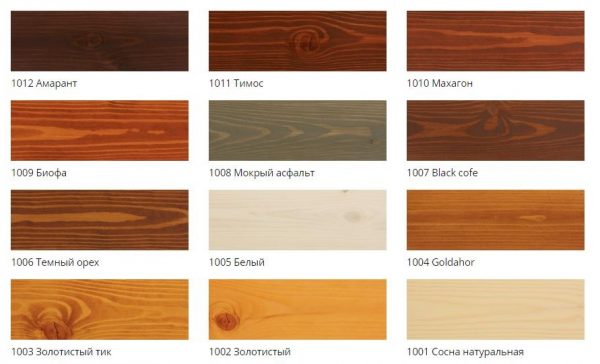
Manufacturers produce glazing compositions of various tones. For example, in Belinka brand impregnations, colors include walnut, oak, pine, teak, larch, and many other wood-like shades. Some azure have a gray or beige hue and are used on old wood to visually renew it. You can change the tone yourself by adding gold, silver or color pigment to the composition. A variety of colors, an interesting visual effect, practicality and ease of use makes the azure incredibly popular among professionals and in home use.

